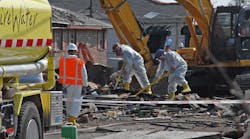The U.S. Department of Homeland Security's Federal Emergency Management Agency (FEMA) has released federal aid for Louisiana and Missippi to supplement state and local recovery efforts in the area affected by Hurricane Isaac.
Hurricane Isaac, which pummeled Louisiana on the anniversary of Hurricane Katrina, brought devastation to areas of the Gulf of Mexico that saw relatively little damage from Katrina. Massive flooding, the result of 20 inches or more of rain dropped by the slow-moving Isaac, caused levies to overflow and flood neighborhoods in the Plaquemines Parish of Louisiana, creating scenarios – people stranded on rooftops and in attics and swimming for their lives – eerily reminiscent of those seen in New Orleans when the levies breeched during Katrina.
Federal funding is available to Louisiana and Mississippi state, tribal and eligible local governments and certain private nonprofit organizations on a cost-sharing basis for emergency work in certain parishes and counties. In Louisiana, the parishes include Acadia, Allen, Ascension, Assumption, Avoyelles, Cameron, East Baton Rouge, East Feliciana, Franklin, Iberia, Iberville, Jefferson, Jefferson Davis, Lafourche, Livingston, Morehouse, Natchitoches, Orleans, Ouachita, Plaquemines, Pointe Coupee, Rapides, St. Bernard, St. Charles, St. Helena, St. James, St. John the Baptist, St. Martin, St. Mary, St. Tammany, Tangipahoa, Terrebonne, Vermilion, Washington and West Baton Rouge. Amite, Attala, Carroll, Clarke, Copiah, Covington, Forrest, George, Greene, Grenada, Hancock, Harrison, Hinds, Holmes, Jackson, Jasper, Jefferson Davis, Jones, Lamar, Lauderdale, Lawrence, Lincoln, Madison, Marion, Montgomery, Pearl River, Perry, Pike, Rankin, Stone, Walthall, Wayne, Wilkinson and Yazoo counties in Mississippi will receive federal disaster recovery funding.
Federal funding also is available on a cost-sharing basis for hazard mitigation measures statewide in both states. Gerard M. Stolar has been named federal coordinating officer for federal recovery operations in Louisiana. He said additional designations may be made at a later date if requested by the state and warranted by the results of further damage assessments. Terry L. Quarles has been named the federal coordinating officer for federal recovery operations in Mississippi. Quarles said that additional counties and forms of assistance may be added after the preliminary damage assessments are fully completed.
OSHA Guidance
Response and recovery work in hurricane-impacted areas presents safety and health hazards that should be properly identified, evaluated and controlled in a systematic manner to reduce or eliminate occupational safety and health risks to response and recovery workers. OSHA’s Hurricane e-Matrix provides information on assessing and controlling the hazards common to most response and recovery work in hurricane-impacted areas.
The e-matrix includes engineering controls, work practices and appropriate PPE for common hazards such as structural instability; contact with downed lines, live electrical equipment and other utilities (e.g., gas, water); unexpected start-up of machines or equipment, or release of stored energy during servicing and maintaining machines and equipment; noise; fall from heights and through openings; asbestos; lead; impact hazard to eyes and face from flying objects; manual handling of materials/weight; unknown chemicals; cuts and lacerations; slips, trips and falls; personal hygiene and decontamination; clothing, tools and equipment decontamination; fatigue and stress; heat or cold stress; animal bites, stings and aggressive behavior; contact with poisonous plants; and sunburn.
Hurricane Recovery Efforts
With parts of the states of Louisiana and Mississippi still recovering from hurricanes Katrina and Rita, FEMA announced it has provided approximately $19.1 billion over the past 7 years to Louisiana to help communities and families rebuild and improve their capabilities to protect against future hazards.
“Since 2005, FEMA has remained committed to this state’s post-Katrina recovery. The Louisiana that we celebrate today with our local and state partners represents the ‘whole community’ and the progress than can occur when people work together,” said FEMA’s Louisiana Recovery Office Executive Director Joseph Threat.
To assist in rebuilding disaster-damaged public infrastructure, FEMA’s Public Assistance Program has provided approximately $11.5 billion for the restoration of roughly 23,669 Katrina and Rita recovery projects throughout Louisiana, including:
- $3.9 billion for education and learning facilities
- $1.1 billion for public safety facilities
- $5.4 billion for general infrastructure (e.g., roads, transportation, parks and sewerage and water facilities)
- $1.1 billion for health care facilities
Following hurricanes Katrina and Rita, hundreds of thousands of Louisiana residents needed help rebuilding their lives. To aid these residents, FEMA provided approximately $5.8 billion in Individuals and Households Program grants to 915,884 individuals and families statewide. This funding was used for housing assistance for rent, repairs and replacement housing, as well as other needs assistance for such things as furniture, clothing and replacement vehicles.
FEMA also housed more than 92,000 households in travel trailers, park models and mobile homes across Louisiana to combat the largest housing shortage ever seen in the agency’s history. Units were located on private properties, at industrial sites, in commercial mobile home parks and across 111 FEMA built and maintained group sites throughout the state.
“Another major recovery milestone was reached this year when, in July, the last FEMA temporary housing unit was removed from this state, marking the first time since 2005 that there have been no FEMA temporary housing units in Louisiana. This means thousands of families once devastated by Katrina are now living in more permanent housing,” said Threat on Aug. 22.
Whether FEMA trailers will once again be found in Louisiana remains to be seen, as areas of the state begin cleanup following Hurricane Issac.
